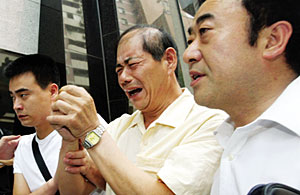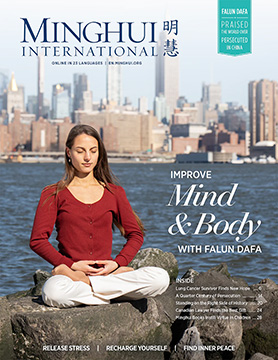|
|
Sun Liusong's son, Sun Zhigang, was beaten to death in a detention center in March 2003
Had it ended differently, Sun Zhigang's life might have been a testament to his country's progress. The 27-year-old carpenter's son had worked his way out of a remote village in China's central Hubei province to a university in the provincial capital of Wuhan. He graduated with an arts degree, then later moved to Guangzhou, landing a job as a graphic designer and the chance to make a home in new China's glittering boomtown. But three weeks into his new life, Sun's luck ran out. On his way to an Internet café, he was stopped by police and asked for his ID. When Sun said he had left it at home, the police took him to a nearby station. By the next day when his boss and friends showed up with the necessary papers, Sun had been transferred to a detention center for vagrants. Two days later, on March 20, he was dead, the victim of a brutal beating in the center's infirmary.
Last week, in a highly secretive trial, a Guangzhou court meted out harsh punishments--including two death sentences--to those deemed to be the culprits in Sun's death. They included a nurse alleged to have ordered other inmates to beat Sun, and the inmates accused of complying. But the major accomplice in Sun's death got off free. The bulk of the blame for Sun's death ought to fall on a little-known system of administrative detention--that is, detention outside of the criminal justice system--whereby Chinese citizens can be locked up merely for being in the wrong place at the wrong time. "Custody and repatriation," as the system is euphemistically called, exists to enforce laws that keep impoverished rural dwellers from overcrowding the country's more prosperous cities. Officially, custody-and-repatriation (C.-and-R.) centers are responsible for detaining vagrants, beggars and those who lack permits to live in cities, and returning them to their hometowns. In reality, say human-rights experts and those who have experienced the system firsthand, it's a terrifyingly arbitrary and routinely abused tool of state power that, at its worst, amounts to little more than a police-enforced kidnapping-and-ransom scheme.
Because most of the 3 million people who find themselves in C.-and-R. centers each year belong to the country's floating population of migrant laborers--the lowest of the low in China's quickly re-emerging class pyramid--abuses tend to be overlooked except in the most egregious cases. Although several of these instances have made it into the national press, they rarely elicit calls for reform.
Until now. Since late April when a Guangzhou newspaper, the Southern Metropolis News, published a detailed account of Sun's case, China's media, academic circles and Internet chat rooms have been abuzz with demands for reform and even abolition of the system. Sun's status as a college-educated up-and-comer rather than an out-of-work farmhand has fueled widespread outrage. "You were imprisoned because you would not be a pet animal or a slave," read one of many eulogies to Sun posted on the Internet. Lending force to this outcry is the fact that China's recent experiences with SARS have aroused a strong sense of public concern about good governance. Two groups of Beijing-based legal scholars have sent petitions to China's National People's Congress, calling for an inquiry into Sun's case and arguing that the C.-and-R. system is illegal under at least two separate Chinese laws. "This case has become a national event," says Xiao Han, an author of one of the petitions. "The government has no choice but to address it."
Still, few expect the system to change anytime soon. C. and R. is as old as the People's Republic. It's been around in one form or another since it was first used in 1950 to clear loitering nationalist troops from cities newly liberated by the communists. And although China's leaders might recognize that mobility among the populace is necessary for enabling economic growth, they fear that unfettered freedom of movement would inundate cities with refugees from the poverty-stricken countryside. Additionally, the C.-and-R. apparatus provides a convenient way for the authorities to deal with all kinds of undesirables. Those who travel to Beijing to petition the central government or complain of local corruption, for example, often fall into its clutches. "Since China has no mechanism or judicial body to ensure its government policies adhere to its own laws," says a legal scholar in Beijing who asks not to be identified, "nothing will change until someone at the very top wants it to."
For now, the manner in which the Sun family's lawsuit against Guangzhou's government was resolved seems a more telling indicator of what's to come. Pressure from the media meant that an unprecedented number of state employees were disciplined. But the Guangdong provincial government issued a statement declaring that its C.-and-R. procedures are consistent with national policy. Sun's father, meanwhile, received a $53,000 settlement--and a team of police escorts, he told Time, to prevent him from discussing the case with the media. Nicolas Becquelin, research director of the New York City-based Human Rights in China organization, observes, "A scapegoat had to be found for a problem that is much larger than this case. The trial was incredibly quick and typically opaque. It allowed the authorities involved to be seen as responsible without actually changing anything."
Conditions inside C.-and-R. centers are so appalling, even by the grim standards of China's penal institutions, that they won't stay secret forever. Tong Yi, a New York City-based lawyer and human-rights activist who did time in both a re-education labor camp in her native Wuhan and in Beijing's main C.-and-R. center before being granted political asylum in the U.S., describes hellish scenes of healthy children and adults and the mentally ill locked up together. "Life in the center was chaotic and filthy," she recalls. "There was no drinking water, just a faucet for 100 people, and food was even more scarce and of lower quality than in my labor camp." Beatings by center staff and inmate trusties were a regular occurrence and, says Tong, "inmates were frequently held for ransom until their families could scrape together the money to buy them out." Indeed, just one day after the verdict in Sun's case, Guo Xianli, an accountant from a C.-and-R. center in Hunan province, revealed that his colleagues had teamed up with police in the provincial city of Lianyuan to form a kidnapping-and-ransom ring, which netted nearly $400,000 in four years. They would ensnare traveling peasants with promises of free meals, Guo told the Sanxiang Metropolis newspaper: "They can't get out without paying. If they cry too much the staff will beat them up so badly that they'll never ask to go home again."
Such shakedowns appear to be common. Outside the gates of the Changping C.-and-R. center on the outskirts of Beijing, Liu Yan is standing in the rain hoping for news of his 28-year-old daughter who came south from the northeastern province of Heilongjiang to work in a knitting factory. He lost touch with her more than a month ago, but it's been only a week since he received a phone call from a center employee telling him his daughter had been picked up and that he must come to Beijing and pay $600--more than double the country's average annual income for rural households--to get her back. "The cops say if we don't pay, they'll keep her here for six months," says Liu's wife. "We're trying to lower the price. They haven't let us speak to our daughter. We don't know what we're supposed to do." As a white van pulls up and disgorges another group of handcuffed detainees, Liu and his wife go inside to bargain for their daughter's freedom. With luck, their savings will be her salvation.
----With reporting by Neil Gough/Guangzhou
http://205.188.238.181/time/asia/magazine/article/0,13673,501030623-458835,00.htm
All content published on this website is copyrighted by Minghui.org. Minghui will produce compilations of its online content regularly and on special occasions.
Category: Falun Dafa in the Media










